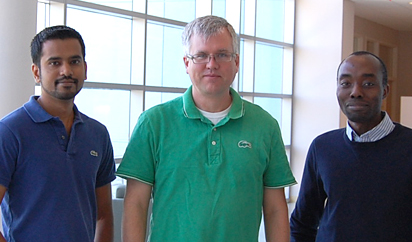Scientists Create Innovative Drug Design Strategy to Improve Breast Cancer Treatment
By Eric Sauter
While there have been advances in the treatment of hormone-driven breast cancer, resistance to these therapies remains a significant problem. Side effects, including an increased risk of uterine cancer among postmenopausal women, also severely curtail their use for cancer prevention.
However, a new study by scientists from the Florida campus of The Scripps Research Institute (TSRI) offers a novel structure-based drug design strategy aimed at altering the basic landscape of this type of breast cancer treatment.
The findings show that the current approach is not the only, or even the best way, to block the estrogen receptor.
“We have created a different approach that gives us a mechanism to produce new types of therapeutic molecules,” said TSRI Associate Professor Kendall Nettles. “There are a lot of ways to avoid resistance and other cancer risks, and this gives us a tool box full of alternative approaches that could limit or eliminate those effects.”
“With the standard method, no one understands the structural basis,” he continued. “With our approach we know exactly how we did it. If you can see the shape of the receptor protein and see how the drug works on it, that makes the development process that much faster.”

Associate Professor Kendall Nettles (center) and Research Associates Sathish Srinivasan (left) and Jerome C. Nwachukwu (right) led the new study.
The findings were published November 21, 2016, by the journal Nature Chemical Biology.
Seeing Is Believing
The current method of creating this class of drugs, which includes tamoxifen, involves attaching a bulky cluster of atoms with a chainlike structure (called, appropriately, a side chain) to molecules that disrupt the estrogen receptor binding site.
The team’s new strategy taps a technique called X-ray crystallography to visualize the drug candidate as it binds to the receptor. This image is used to guide the production of estrogen receptor degraders that also lack the side chain, helping to reduce the risk of resistance and the development of other cancers.
“Our structure-trapping approach to X-ray crystallography provides a molecular snapshot of how subtle changes to a compound series generate a range of graded activity profiles,” said Research Associate Jerome C. Nwachukwu, who was co-first author with Research Associate Sathish Srinivasan. “This structurally distinct mechanism, acting indirectly rather than involvement of the typical side chain, provides a new way to design biologically distinct molecules for breast cancer prevention and treatment.”
The new method also makes it possible to identify structural rules for how the molecules interact.
“This is the first example of a structure-based design strategy targeting the estrogen receptor where there is a clear correlation between the chemistry, crystal structure and activity, which is another big advance that will be of broad interest to the cancer community,” Srinivasan said. “We show that indirect antagonism can result in inhibition of proliferation in a predictive fashion.”
In addition to Nettles, Srinivasan and Nwachukwu, other authors of the study, “Full Antagonism of the Estrogen Receptor without a Prototypical Ligand Side Chain,” include Nelson E. Bruno, Venkatasubramanian Dharmarajan, Devrishi Goswami, Scott Novick, Jason Nowak and Patrick R Griffin of TSRI; Irida Kastrati, Nittaya Boonmuen, Yuechao Zhao, Benita S. Katzenellenbogen and John A. Katzenellenbogen, Jian Min and Jonna Frasor of the University of Illinois; Hai-Bing Zhou of Wuhan University (China).
The study was supported by the National Institutes of Health (PHS 5R37DK015556, 5R33CA132022, 5R01DK077085, 1U01GM102148 and 5R01CA130932); the Breast Cancer Research Foundation, BallenIsles Men’s Golf Association, Frenchman’s Creek Women for Cancer Research, Susan G. Komen for the Cure® (Grant PDF12229484); the National Natural Science Foundation of China (81172935, 81373255, 81573279) and Hubei Province’s Outstanding Medical Academic Leader Program.
Send comments to: press[at]scripps.edu













